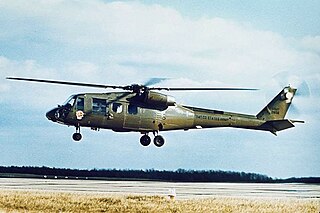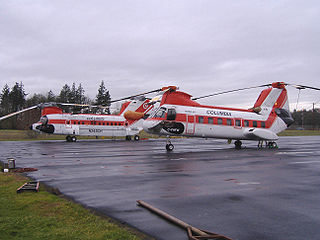
The Boeing Vertol CH-46 Sea Knight is an American medium-lift tandem-rotor transport helicopter powered by twin turboshaft engines. It was designed by Vertol and manufactured by Boeing Vertol following Vertol's acquisition by Boeing.

The Boeing CH-47 Chinook is a tandem-rotor helicopter developed by American rotorcraft company Vertol and manufactured by Boeing Vertol. The Chinook is a heavy-lift helicopter that is among the heaviest lifting Western helicopters. Its name, Chinook, is from the Native American Chinook people of Oregon and Washington state.

The Sikorsky CH-54 Tarhe is an American twin-engine heavy-lift helicopter designed by Sikorsky Aircraft for the United States Army. It is named after Tarhe, an 18th-century chief of the Wyandot Indian tribe whose nickname was "The Crane". The civil version is the Sikorsky S-64 Skycrane.
Boeing Defense, Space & Security (BDS) is a division of The Boeing Company based in Arlington, Virginia. It is responsible for defense and aerospace products and services. It was formerly known as Boeing Integrated Defense Systems (IDS).
Piasecki Helicopter Corporation designed and manufactured helicopters in Philadelphia and nearby Morton, Pennsylvania, in the late 1940s and the 1950s. Its founder, Frank Piasecki, was ousted in 1956 and started a new company, Piasecki Aircraft. Piasecki Helicopter was renamed Vertol Corporation in early 1956. Vertol was acquired by Boeing in 1960 and renamed Boeing Vertol.

A tandem-rotor aircraft is an aircraft with two large helicopter rotor assemblies mounted one in front of the other in the horizontal plane.
Evergreen International Aviation, Inc. was a global aviation services company based in McMinnville, Oregon, United States. Founded in 1960, Evergreen was primarily known publicly for commercial helicopter operations in agricultural and forestry applications.
Boeing Canada is the Canadian subsidiary of Boeing, with operations in Winnipeg, MB, Richmond, BC, Montreal, QC and Ottawa, ON. Boeing employs more than 1,600 people in Canada. Boeing Aircraft of Canada Limited was formed in 1929 by the American Boeing Airplane Company.

The Sikorsky CH-53K King Stallion is a heavy-lift cargo helicopter designed and produced by Sikorsky Aircraft. The King Stallion is an evolution of the long running CH-53 series of helicopters which have been in continuous service since 1966, and features three uprated 7,500 shp (5,590 kW) engines, new composite rotor blades, and a wider aircraft cabin than its predecessors. It is the largest and heaviest helicopter in the U.S. military.
MD Helicopters, LLC. is an American aerospace manufacturer. It produces light utility helicopters for commercial and military use. The company was a subsidiary of Hughes Aircraft until 1984, when McDonnell Douglas acquired it and renamed it McDonnell Douglas Helicopter Systems. It later became MD Helicopters in the late 1990s when McDonnell Douglas merged with Boeing.

The Boeing Vertol YUH-61 was a twin turbine-engined, medium-lift, military assault/utility helicopter. The YUH-61 was the runner-up in the United States Army Utility Tactical Transport Aircraft System (UTTAS) competition in the early 1970s to replace the Bell UH-1 Iroquois helicopter. At the end of the flyoff program, Sikorsky Aircraft was awarded a contract to develop and build its UH-60A entry.

The Bell YAH-63 was an experimental attack helicopter for the Advanced Attack Helicopter (AAH) competition. Hughes' Model 77/YAH-64, later developed into the AH-64 Apache, was selected over Bell's entry.

The Boeing Vertol XCH-62 was a triple-turbine, heavy-lift helicopter project designed for the United States Army by Boeing Vertol. Approved in 1971, one prototype reached 95% completion before it was canceled in 1975. The prototype was scrapped in 2005.

Columbia Helicopters, Incorporated (CHI) is an aircraft manufacturing and operator company based in Aurora, Oregon, United States. It is known for operating tandem rotor helicopters; in present times, exclusively the Boeing Vertol 107 and Boeing Vertol 234. These helicopters are used in stream restoration and forestry, including heli-logging, aerial firefighting, oil exploration, construction, government support, film production, disaster response, and many other activities. In addition, the company operates a large FAA repair station supporting customers worldwide.

The Solar T62 Titan is an American gas turbine engine used mainly as a helicopter auxiliary power unit (APU), ground power generator, turboprop engine or helicopter turboshaft engine. A free power turbine version was developed as the Solar T66.

Future Vertical Lift (FVL) is a plan to develop a family of military helicopters for the United States Armed Forces. Five different sizes of aircraft are to be developed, sharing common hardware such as sensors, avionics, engines, and countermeasures. The U.S. Army has been considering the program since 2004. FVL is meant to develop replacements for the Army's UH-60 Black Hawk, AH-64 Apache, CH-47 Chinook, and OH-58 Kiowa helicopters. The precursor for FVL is the Joint Multi-Role (JMR) helicopter program.















